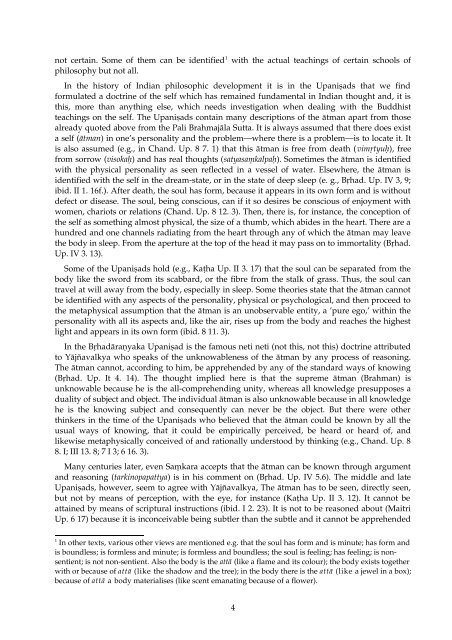The Truth of Anatta - Buddhist Publication Society
The Truth of Anatta - Buddhist Publication Society
The Truth of Anatta - Buddhist Publication Society
You also want an ePaper? Increase the reach of your titles
YUMPU automatically turns print PDFs into web optimized ePapers that Google loves.
not certain. Some <strong>of</strong> them can be identified 1 with the actual teachings <strong>of</strong> certain schools <strong>of</strong><br />
philosophy but not all.<br />
In the history <strong>of</strong> Indian philosophic development it is in the Upaniṣads that we find<br />
formulated a doctrine <strong>of</strong> the self which has remained fundamental in Indian thought and, it is<br />
this, more than anything else, which needs investigation when dealing with the <strong>Buddhist</strong><br />
teachings on the self. <strong>The</strong> Upaniṣads contain many descriptions <strong>of</strong> the ātman apart from those<br />
already quoted above from the Pali Brahmajāla Sutta. It is always assumed that there does exist<br />
a self (ātman) in one’s personality and the problem—where there is a problem—is to locate it. It<br />
is also assumed (e.g., in Chand. Up. 8 7. 1) that this ātman is free from death (vimṛtyuḥ), free<br />
from sorrow (visokaḥ) and has real thoughts (satyasaṃkalpaḥ). Sometimes the ātman is identified<br />
with the physical personality as seen reflected in a vessel <strong>of</strong> water. Elsewhere, the ātman is<br />
identified with the self in the dream-state, or in the state <strong>of</strong> deep sleep (e. g., Bṛhad. Up. IV 3, 9;<br />
ibid. II 1. 16f.). After death, the soul has form, because it appears in its own form and is without<br />
defect or disease. <strong>The</strong> soul, being conscious, can if it so desires be conscious <strong>of</strong> enjoyment with<br />
women, chariots or relations (Chand. Up. 8 12. 3). <strong>The</strong>n, there is, for instance, the conception <strong>of</strong><br />
the self as something almost physical, the size <strong>of</strong> a thumb, which abides in the heart. <strong>The</strong>re are a<br />
hundred and one channels radiating from the heart through any <strong>of</strong> which the ātman may leave<br />
the body in sleep. From the aperture at the top <strong>of</strong> the head it may pass on to immortality (Bṛhad.<br />
Up. IV 3. 13).<br />
Some <strong>of</strong> the Upaniṣads hold (e.g., Kaṭha Up. II 3. 17) that the soul can be separated from the<br />
body like the sword from its scabbard, or the fibre from the stalk <strong>of</strong> grass. Thus, the soul can<br />
travel at will away from the body, especially in sleep. Some theories state that the ātman cannot<br />
be identified with any aspects <strong>of</strong> the personality, physical or psychological, and then proceed to<br />
the metaphysical assumption that the ātman is an unobservable entity, a ’pure ego,’ within the<br />
personality with all its aspects and, like the air, rises up from the body and reaches the highest<br />
light and appears in its own form (ibid. 8 11. 3).<br />
In the Bṛhadāraṇyaka Upaniṣad is the famous neti neti (not this, not this) doctrine attributed<br />
to Yājñavalkya who speaks <strong>of</strong> the unknowableness <strong>of</strong> the ātman by any process <strong>of</strong> reasoning.<br />
<strong>The</strong> ātman cannot, according to him, be apprehended by any <strong>of</strong> the standard ways <strong>of</strong> knowing<br />
(Bṛhad. Up. It 4. 14). <strong>The</strong> thought implied here is that the supreme ātman (Brahman) is<br />
unknowable because he is the all-comprehending unity, whereas all knowledge presupposes a<br />
duality <strong>of</strong> subject and object. <strong>The</strong> individual ātman is also unknowable because in all knowledge<br />
he is the knowing subject and consequently can never be the object. But there were other<br />
thinkers in the time <strong>of</strong> the Upaniṣads who believed that the ātman could be known by all the<br />
usual ways <strong>of</strong> knowing, that it could be empirically perceived, be heard or heard <strong>of</strong>, and<br />
likewise metaphysically conceived <strong>of</strong> and rationally understood by thinking (e.g., Chand. Up. 8<br />
8. I; III 13. 8; 7 I 3; 6 16. 3).<br />
Many centuries later, even Saṃkara accepts that the ātman can be known through argument<br />
and reasoning (tarkinopapattya) is in his comment on (Bṛhad. Up. IV 5.6). <strong>The</strong> middle and late<br />
Upaniṣads, however, seem to agree with Yājñavalkya, <strong>The</strong> ātman has to be seen, directly seen,<br />
but not by means <strong>of</strong> perception, with the eye, for instance (Kaṭha Up. II 3. 12). It cannot be<br />
attained by means <strong>of</strong> scriptural instructions (ibid. I 2. 23). It is not to be reasoned about (Maitri<br />
Up. 6 17) because it is inconceivable being subtler than the subtle and it cannot be apprehended<br />
1<br />
In other texts, various other views are mentioned e.g. that the soul has form and is minute; has form and<br />
is boundless; is formless and minute; is formless and boundless; the soul is feeling; has feeling; is nonsentient;<br />
is not non-sentient. Also the body is the attā (like a flame and its colour); the body exists together<br />
with or because <strong>of</strong> attā (like the shadow and the tree); in the body there is the attā (like a jewel in a box);<br />
because <strong>of</strong> attā a body materialises (like scent emanating because <strong>of</strong> a flower).<br />
4

















